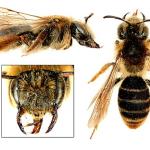A fairly large Andrena, comparable in size with A. scotica Perkins, but patterned more like A. fulvago (Christ) with darker wings. It has only been recorded in Britain on a few occasions: by F Smith in the middle of the nineteenth century, and subsequently with a number of records in the early 1900s and again in the 1930s. All these records relate to that part of Kent north of Maidstone, so it may well have been a species with several short-lived invasions, but which failed to become more widely established.
This species has only been found in the extreme south-east of England.
It is widespread in Southern and Central Europe
This species is listed in Shirt (1987) and in Falk (1991) as Endangered (RDB1).
All known British records come from areas of calcareous soils.
Univoltine; late May to early August.
Although not reported from Britain, it is known to nest in small aggregations within areas of bare ground in other parts of Europe.
It is said to favour chicory (Westrich, 1989), but is also recorded at a range of other Asteraceae, such as hawkweed, hawkbit and cat’s-ear.
Nomada integra Brullé is a known cuckoo of this species.
2018


